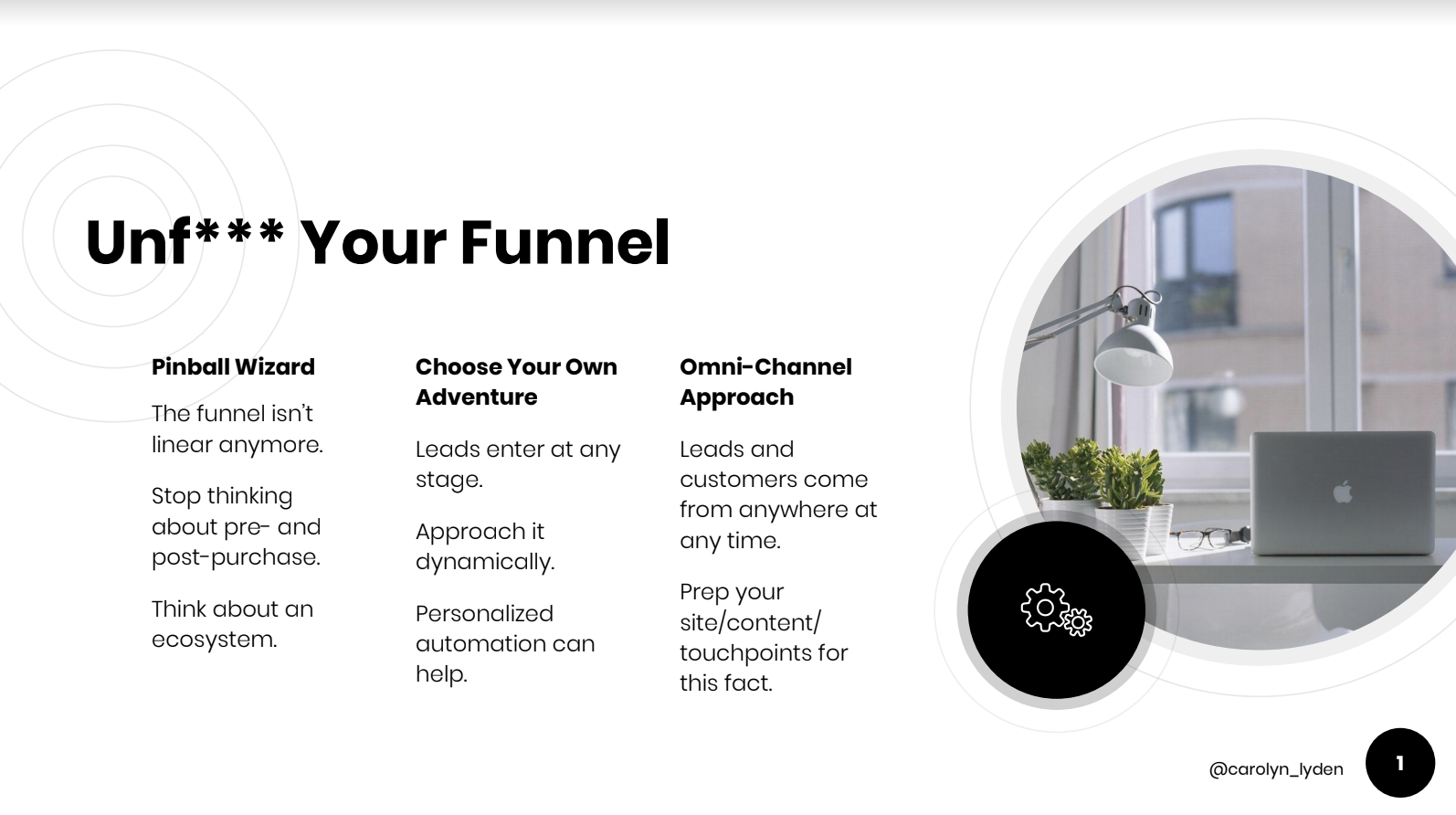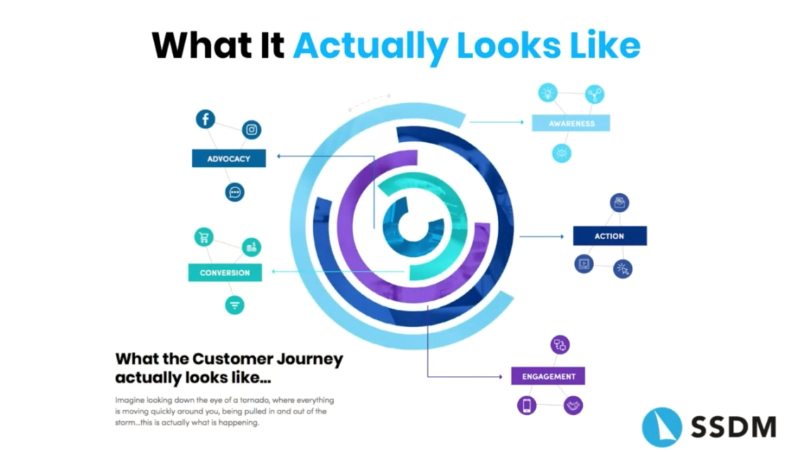If you follow this blog, you know we’re all about leveraging data to improve marketing strategy. As digital marketers, we have the opportunity to capture data from multiple channels to understand our audience. However, by looking at past data, marketers tend to fall into a common trap: focusing on existing audiences only. In order to build your business, you need to look beyond their CRM and reach out to new audiences — new audiences who will convert. If you’re looking for a marketing funnel strategy that makes a difference in your bottom line – personalization is the way to go.
Great marketing funnel strategy means targeting the right buyer(s) – are you?
We’re talking about building personalized campaigns for current and new audiences. In order to start thinking about personalization, think back to a lesson from Marketing 101: the buyer persona. A buyer persona is a semi-fictional representation of your ideal customer based on market research and real data about your existing customers. What would this ideal customer’s interests be? What media do they engage with, and what products do they like?
You may have built a “perfect customer” in a marketing class, or maybe you have a co-worker who calls your buyer persona “Lindsay” and knows that “Lindsay” has four cats, two children, and an affinity for jigsaw puzzles. Regardless, thinking about the audience is something that we, as marketers, do every day. But is your audience persona really the audience you think it is? Or are you making assumptions that lose conversions? Are we building an authentic brand that will resonate with our audience and build relationships that last?
When we start targeting a specific demographic, we miss other potential demographics. That’s a real opportunity cost! Say you’re marketing luxury watches: it’s fair to think your default demographic might be affluent men who live in a home that costs a certain amount or own a boat. But, by creating campaigns geared toward that demo, you may lose interest from younger men, women, or people buying gifts. By creating multiple campaigns targeting topics related to luxury watches, you can cast a wider net.
Wait, marketing personas are wrong?
No. They’re not wrong. BUT – they may be holding you back from creating content that will convert.
Understanding the demographics and creating these personas can help people visualize an end user. And that can help make the writing process easier because you feel you are “talking to someone” specific. That said, consider you may be talking to several someones in the same topic.
Going to a grocery store is a really good example. If you watch the cereal aisle and see who buys Cheerios for instance, you’ll notice there are LOTS of demographics at play. Whether it’s gender, age, race, income bracket, etc. – there’s a wide variety. We’re not suggesting that personas don’t work for this, we’re suggesting that a topic-based approach to Cheerios would likely circle in several of those folks together instead of having to create campaigns that single them out. But we’ll come back to the topic situation in a minute.
Don’t relegate personalization to lead generation
An issue we see in larger organizations, as well as organizations of all sizes, is the branching of customer outreach into a marketing bucket and a sales bucket. When we’re talking about personalizing content for the funnel, personalization shouldn’t start with marketing and stop with sales: the experience should be personalized all the way through. Create consistency by using content through the sales experience that is similar to the content, look, and feel of the landing pages or social ads that brought them to you in the first place.
The content we create to build interest and engagement, especially in search and social. Once the interest and engagement is captured, marketing can provide the right type of content to sales reps for the leads generated from the marketing activities. Content should drive and build on intent. You want to get your customer to a sales manager who can build personalization through the buying process, onboarding, and customer service experience. If you aren’t sure whether your sales funnel is accomplishing this goal, step back and go through the customer experience yourself (or, even better, using a series of test customers). If you find that personalization goes out the window as soon as a lead is generated, fix that problem!

You should also consider personalization as a way to encourage existing customers to engage with additional products. Use customer data to show your customers other products or services that similar users buy. If possible, point them to a testimonial of a similar user, and highlight ways that your products work together.
Think topics, not traits
It’s hard to personalize content based on user demographics: “males, age 30-40, with an income over $50,000” is still a broad demographic, with users who may have very little in common with one another. To combat this issue, build your marketing personas based on topics of interest rather than broad personality traits.
We talk a lot about the symbiosis between search and social: both revolve around the native discussion of topics relevant to the audience. Data from these platforms moves beyond the question of “who’s in your network” and focuses on what people are interested in, and what actions people with certain interests take. Data from search and social media are great tools for building your personalized topics!
Here are some reasons topics trump traits when it comes to a good marketing funnel strategy:
- Topics can be relevant to people with different traits
- Topics are relevant at different times, and may be tied to traits or independent
- Topics allow us to capture ALL potential audiences instead of excluding those whose traits didn’t match

Start by really using data; again, social media and search are great places to start. Social media provides tons of KPIs: look at who engages with your posts and use that information to figure out what content will resonate with your audience, and what actions that content drives. And, consider your competitor’s content: if you’re trying to create a funny social media post, look at popular Facebook posts and examine the reaction types — the posts getting the “haha” reaction are probably funnier.
Consider who your content is influencing
Personalizing for a lot of people seems daunting and expensive. How can we build content for multiple personas without breaking the bank? It’s all about tailoring that content creation to the leads that will make the most impact.
If you’re in an industry driven by influencers, looking at your top followers is a great place to start — but not the only place. There are influencers, and there are the people who influence influencers. When you’re looking at whether your content was impactful and highly-shared, look at a granular level at who is re-sharing that content, how people are reacting to those re-shares, and what responses the content is getting. Reach isn’t the only metric. Get your content in front of users who are not only potential buyers, but potential content generators.
The content formats and reach technologies of today are wildly different than content from even a few years ago. Instagram Stories, for example, have a huger reach today than Instagram Feed. As new media types roll out, keep an eye on those channels that have a bigger reach and put your spend there. New, less-polished channels like live video can pay off — so it may be worth stepping out of your comfort zone!
Create a lot of content and use that content to experiment
Even if you have a huge budget, you don’t need to spend it all on the most-storyboarded, highest-level content creation money can buy: especially when creating pricier content is a slow process. Not every video has to be high-budget, Hollywood quality– remember that high-budget video sometimes flops. Instead of creating the most expensive content, create more content and actually see what works. If you’re taking forever to create a single set of reactions, you simply won’t get enough reactions to build an understanding of what works and what doesn’t. If something really fails, remember: this is the internet. You can take that failed piece of content down and start again.
Not sure where to start on creating successful content? Check out our previous post about successfully filtering your content through SEO as you build it.
If you want help with a topic targeting strategy, we’ll help you develop a keyword list and priorities for your content. Get started here.
